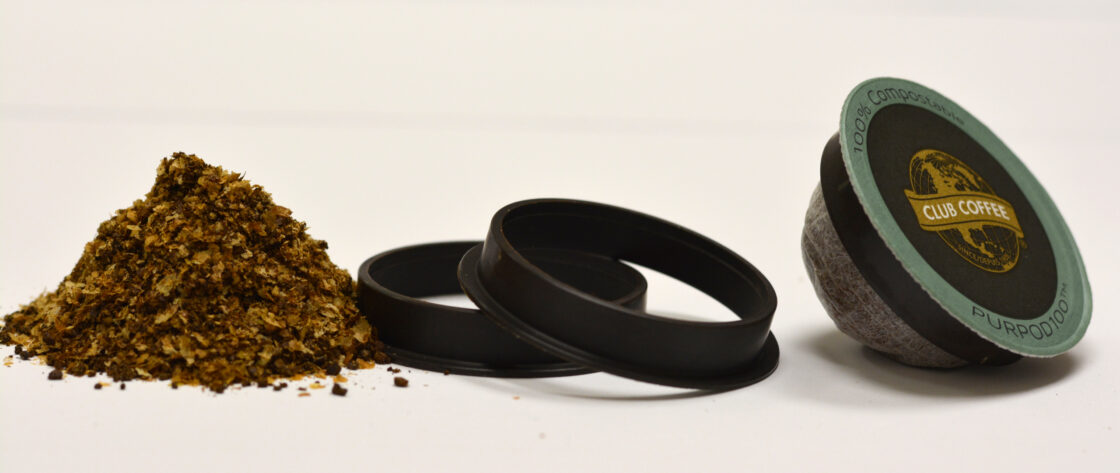Are Sustainable Coffee Pods an Oxymoron or Can ‘Green’ Single-Serve Coffee Become a Reality?

Single-serve coffee pods are a major waste of space. They’re polluting landfills by the millions–but could they be a more ecological, even better way to get your morning brew than regular drip? That’s exactly the question that Hills Bros. asked themselves in developing the very first certified 100 percent compostable coffee pods this April – the PURPOD100.
Compatible with Keurig-style coffee makers, the PURPOD100 is meant to bring better flavor than many other coffee pods.
“Freshly roasted, whole-bean coffee, just ground, will always produce a more complex cup than pod coffee,” says Kim Westerman, Associate Editor of Coffee Review. “That said, coffee pods have improved enormously in quality in recent years, both in terms of sourcing and in terms of the sophisticated devices used to brew them.”
“Before, when brewing single serve plastic cups, the aroma is missing until the coffee is in the cup,” says Sarah Cunningham, Senior Brand Manager at Hills Bros. Coffee. These new pods, however, are designed to bring back the aroma and flavor of brewed coffee. They are also designed to be composted.
Compostable — But Not Landfill-Friendly — Coffee Pods
PURPOD 100 is certified by the Biodegradable Products Institute as being 100 percent compostable. “Once the coffee is brewed, the entire coffee pod can be composted in a commercial composting facility to become nutrients back to the soil,” says Cunningham.

The ring of the pod is made using coffee chaff, which is recaptured from roasting operations and combined with plant-based resins. The filter and lid are made with paper and polylactic acid (PLA), a popular bioplastic derived from corn.
Camille Drozdz, a French designer specialized in ecological and reuse design, notes that the most globally recognized certification for products of this kind is the C2C certification or Cradle to Cradle, something that Cunningham says the company has yet to explore.
“It is something we may pursue down the road if we believe consumer awareness warrants it and if we feel the certification holds credibility with consumers and retail partners,” she says.
Drozdz does note that the idea of a completely compostable coffee pod is indeed plausible. “It seems really interesting,” she says. “I’ve never seen a product like this, and I think it’s a good idea to be able to compost as many products as possible, given the astronomical number of things we consume each day.”
The Downside
This said, however, the coffee pods are only compostable under certain circumstances: the pods will not break down in landfills and must instead be composted in a bin or commercial compost facility.
“Sadly, very little breaks down in landfill,” Cunningham says. “This is a key reason for the increasing push for food waste diversion through composting.”
“In this situation of organic material in close contact with a small amount of packaging, as a single serve coffee pod, composting is the only practical and convenient solution – practical in that deals with the entire waste stream and convenient in that it doesn’t require additional consumer effort. That last point alone means that it has great potential for consumer compliance.”
Where Does PURPOD100 Rank Amongst Other Green Coffee Pods?
Drozdz’s work has led her to discover other products in the same vein as the PURPOD100, such as VEGEPLAST, a Nespresso-type capsule made of bioplastic, and ECO CAPSULE, a similar bioplastic capsule designed to be filled at home.
Nespresso has also created a tool to separate the aluminum rings on some pods and has made depots available where these capsules can be recycled, and the (somewhat) recyclable Ecocup was introduced in the States in 2014.
By and large, compostable coffee pods are more eco-friendly than recyclable pods… if the user decides to make the effort, that is.
“I’m not a scientist, but as a consumer the idea that something is compostable but doesn’t break down in a landfill seems unsatisfying,” says Westerman.
She also has suggestions on how to ensure the very greenest cup. Firstly, choose fair-trade and organic coffee whenever possible, but be aware of the cost of certification; knowing the origins of the coffee you buy is always best, regardless of labels.
“As far as brewing is concerned, French press is probably, strictly speaking, the ‘greenest’ method, but a pourover using a paper filter is pretty good, too.”
What’s your favorite way to serve up a morning cup of fair-trade joe? Share your thoughts with us via Facebook or Twitter.
Related on Organic Authority
Want to Know How to Make Tortillas? With Coffee Pods, of Course
Soup Made with Coffee Pods and Other Ridiculous Single Serve Foods
You Know What’s Dumb? A Disposable ‘French Press’ Coffee Maker
Images care of PURPOD100

